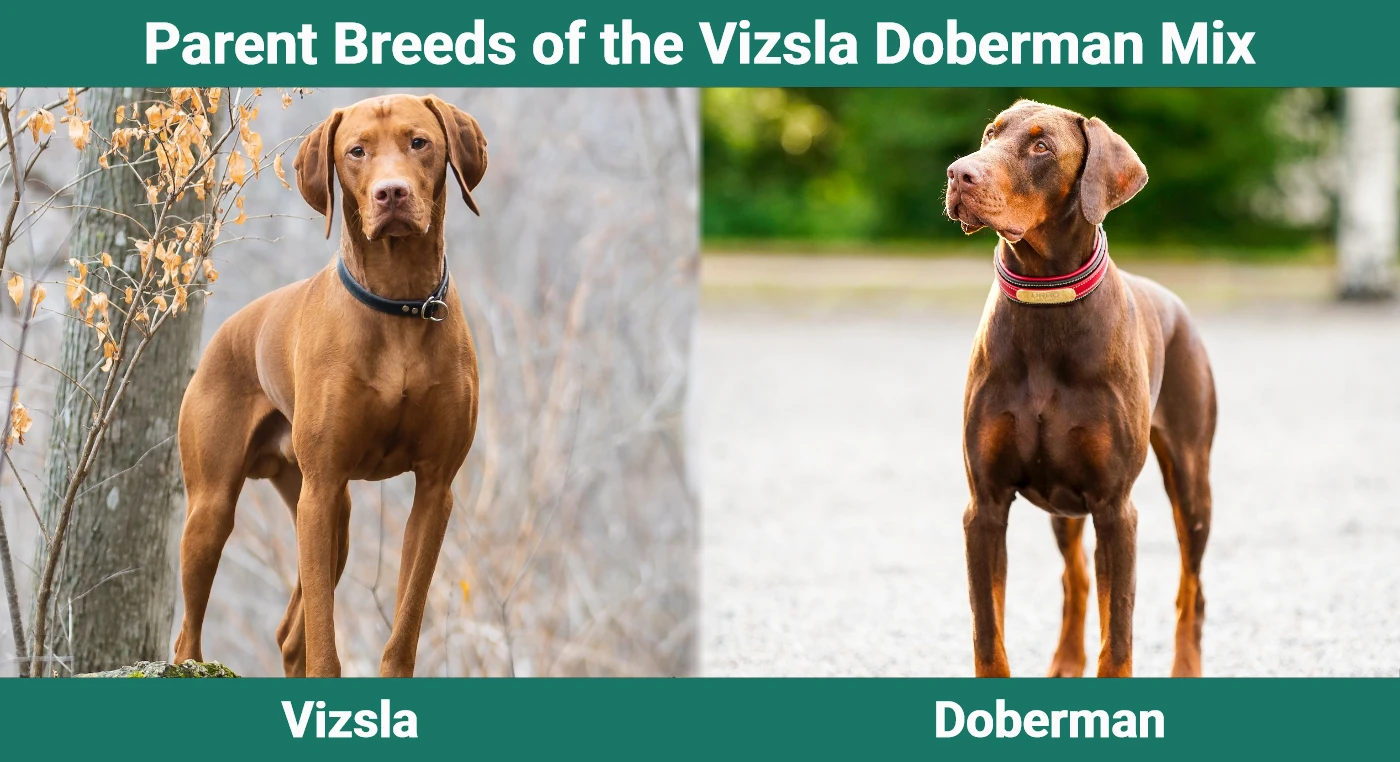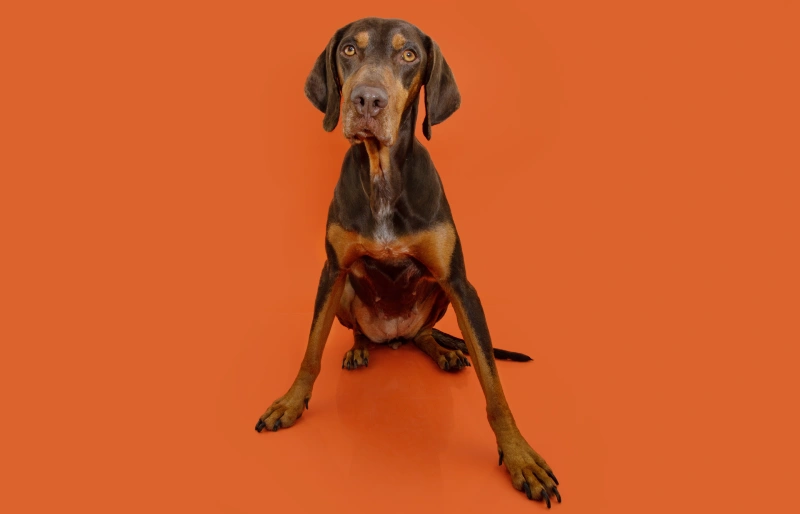Click Below to Skip Ahead
The Vizsla Doberman is a sleek, playful, and loving dog that pairs the boundless energy of the Vizsla hunting dog breed with the protective nature of the Doberman. This intelligent mixed breed has many redeeming qualities to offer its humans. Still, it needs an owner willing to put forth the time and effort necessary to train and socialize it properly. The Vizsla Doberman can be demanding and won’t fit into every family dynamic.
Read on to learn more about this hybrid dog breed to see if it’s the right pick for your family and lifestyle.
Breed Overview
Height:
21–28 inches
Weight:
45–100 pounds
Lifespan:
10–14 years
Colors:
Black, red, blue, fawn, white, golden rust
Suitable for:
Active families, single-family households with an active lifestyle
Temperament:
Loyal, affectionate, devoted, intelligent, friendly
The Vizsla Doberman mix can pair the best traits of both parent breeds to bring dog owners a loving, loyal, friendly, and devoted family member. However, its parent breeds have some stark differences, making its personality hard to predict. For example, Vizsla Doberman puppies may grow to be gentle and sensitive like their Vizsla parent or fearless and protective like their Doberman side.
Vizsla Doberman Mix Puppies
The Vizsla Doberman puppy can be very rambunctious and playful. Its main focus is to burn off the excess energy it has pent up and explore its world through play. As such, it may not understand that small children can get hurt when it gets so rowdy. This puppy must begin training and socialization from a young age to learn how to behave in different social situations. Regardless of breed, a poorly trained or socialized dog will be difficult to control and more likely to exhibit bad behaviors.
There aren’t many Vizsla Doberman breeders that we could find in our research; therefore, you may have problems finding a puppy to buy right away. Several rescues with Vizsla x Doberman mixes are available, so you may have better luck adopting versus buying from a breeder.

Temperament & Intelligence of the Vizsla Doberman Mix
It’s hard to know for sure what the temperament of the Vizsla Doberman mix would be, as each dog from a litter could have an entirely different personality. One pup may favor its Doberman side, being trustworthy, playful, and fun-loving with its family members. At the same time, another may take after its Vizsla side and be energetic, athletic, and gentle. Thanks to its Doberman DNA, it may have a strong instinct to protect its family members or a strong prey drive from its Vizsla side.
Pups favoring the Doberman side will make great guard dogs with a formidable presence and imposing physical appearance. Those that take after their Vizsla parent will have a penchant for playfulness, and their high intelligence makes them highly trainable.
Both parent breeds share some similar traits, however, so it is likely that a Vizsla Doberman will be intelligent, trainable, loyal, and affectionate. This mix is so dedicated and devoted to its humans that it is sometimes called a “Velcro dog”, as they will always stick close to their people.
Are These Dogs Good for Families? 👪
The Vizsla Doberman can make a great family dog, provided it is given proper training, socialization, and plenty of opportunities for daily, vigorous exercise. They can be great for families with children, but it may be best to wait until your kids are older to adopt such a dog. They may not be an extra-large breed, but they’re still big and powerful, so a small child could get hurt or knocked over accidentally during a vigorous play session.
Does This Breed Get Along With Other Pets? 🐶 😽
The Vizsla Doberman mix generally gets along with other dogs of the opposite sex. However, some issues may arise with same-sex aggression, especially between two males. The key to preventing or reducing such aggression is early socialization.
The Vizsla Doberman can live harmoniously with cats, provided the two are introduced properly. The earlier you can introduce the two species, the better the likelihood that they’ll not only get along with one another but live happily together.
This mixed breed isn’t the best option if you have smaller animals, such as guinea pigs or pet birds, of the Vizsla’s strong prey drive.
Things to Know When Owning a Vizsla Doberman Mix
Food & Diet Requirements 🦴
The Vizsla Doberman is a medium-sized, muscular dog that requires a high-quality diet to feed its muscles and remain healthy. The best food for this mixed breed is specially formulated for large or active breeds. Choose commercial foods with real meat as the first ingredient to ensure your pup gets a high-quality protein source. It’s best to steer clear of grain-free diets unless your veterinarian recommends it, as there may be a link between such diets and dilated myocardiopathy (DCM). A Doberman is already predisposed to developing DCM, so it’s best to consult your vet before opting for a diet that may cause issues.
Feed your Vizsla Doberman an age-appropriate diet, as the nutritional needs of your dog as a puppy will differ from when it reaches adulthood.
Speak to your vet to determine how much you should feed your dog. They will consider your dog’s age, activity level, and other health factors to determine how many calories it needs daily.
Exercise 🐕
The Vizsla Doberman mix needs at least one and a half hours of daily exercise. You can split this into several walks throughout the day, though it should be provided some time to run off-lead in a secure and safe space. If you fail to give your dog the space to burn off some energy, it will create ways to release pent-up energy, and you may not like what activities it chooses to participate in to burn off that steam. In addition, your dog may pick up barking, howling, or chewing habits that can be very difficult to break.
Training 🎾
The Vizsla Doberman should be very easy to train. Both parent breeds are highly intelligent, obedient, and loyal to their owners. The Vizsla Doberman responds well to training due to its eagerness to please its owner.
Start training young to ensure your pup grows into a well-behaved adult. We recommend investing in obedience training to help build your dog’s confidence, improve sociability, and reduce the likelihood of aggression. While the Vizsla generally isn’t an aggressive breed, Doberman Pinschers are instinctually more protective, which may cause aggression in some individuals.
Grooming ✂️
The Vizsla Doberman has a short coat that requires minimal care. You’ll only need to bathe and brush it occasionally. However, if your pup takes after its Doberman side more than its Vizsla, you should be prepared to deal with moderate to heavy shedding. You may need to brush its coat daily or a few times weekly to keep up with the shedding.
We highly recommend making brushing your dog’s teeth part of your routine to minimize dental disease risk.
Health and Conditions 🏥
The Vizsla Doberman is generally a healthy mixed dog, but it may be predisposed to certain health conditions of its parent breeds.
Vizsla dogs may develop hip dysplasia, progressive retinal atrophy, hypothyroidism, and epilepsy. Dobermans may develop gastric dilatation-volvulus, dilated cardiomyopathy, Von Willebrand’s Disease, and hip dysplasia.
This mixed breed may be at risk of obesity if fed too much and not given enough opportunities to exercise. This is especially true as it ages, as they don’t run around as much, and many owners don’t realize they need to cut back on the feeding portions if their pups aren’t as active. Obesity is sadly very common in dogs, but it is entirely preventable. Obese dogs are at a higher risk of developing secondary conditions such as cancer, heart disease, hypertension, and diabetes mellitus.
- Hypothyroidism
- Von Willebrand’s Disease
- Hip dysplasia
- Progressive retinal atrophy
- Epilepsy
- Gastric dilatation-volvulus
- Dilated cardiomyopathy
Male vs Female
As with most dog breeds, the male Vizsla Doberman mix is heavier and bulkier than its female counterpart. Males are usually taller by at least two inches and can weigh as much as 20 pounds more than females.
The personality differences between male and female Vizsla Dobermans can depend on which parent the dog takes after most.
Male Dobermans, especially those unneutered, can be aggressive due to their male sex hormones, while females are typically less threatened but more stubborn and territorial.
Male Vizslas, on the other hand, are often friendlier than females. They’re happy to approach just about anyone and are less likely to become overly attached to just one of their family members. Conversely, female Vizslas are glad to be independent and aren’t overly reliant on their humans for attention.
3 Little-Known Facts About The Vizsla Doberman Mix
1. This mixed breed is known by many names.
You may struggle to find information online about the Vizsla Doberman mix as it goes by many names depending on your source. Some other nicknames for this breed include Vizslamann, Doberla, and even the Vizsladobie.
2. The Vizsla Doberman is a great companion for almost any activity.
The Vizsla is a natural hunter born and bred to work in fields, forests, or water. In its early years, it was used to scent and search birds caught by falcons or in nets. When firearms were invented, it was trained to take on other tasks like tracking wounded game, retrieving birds, and hunting.
The Doberman, on the other hand, is a working dog developed for police and military work. They have long been used as protectors and companions for the home.
3. Both parent breeds have roots in Europe.
Vizsla dogs were developed in Hungary and are considered one of the oldest-known hunting breeds. Their ancestors were brought to Hungary by the Magyars over 1,000 years ago.
Dobermans are a much newer breed developed in Germany in the 1880s. They were bred by a tax collector named Karl Friederich Louis Dobermann, who was set on creating a dog breed that could protect him.
Conclusion
The Vizsla Doberman mix is an athletic, elegant, and loyal dog to keep as a pet. However, its personality and lifestyle will depend entirely on which parent breed it takes after most.
Dogs that favor their Vizsla side will be energetic, curious, loving, and gentle. In addition, they’re competent and intelligent, so they learn quickly and are highly trainable.
Pups with stronger Doberman DNA can possess the same traits but are notoriously protective of their family members. Prominent Doberman DNA may predispose the dog toward aggression with same-sex dogs, strangers, and sometimes even their owners. Of course, you can reduce the likelihood of your dog becoming aggressive through proper training and socialization.
The Vizsla Doberman can make a great family pet regardless of which parent breed shines through most. If you’re adopting one soon, ensure you have the patience to put toward training and lots of spare time to get your pup out to burn off its excess energy.
See Also:
- Border Collie-Vizsla Mix: Care Guide, Pictures, Temperament & More
- Vizsla Pitbull Mix: Care Guide, Pictures, Temperament & More
Featured Image Credit: smrm1977, Shutterstock












